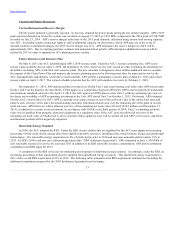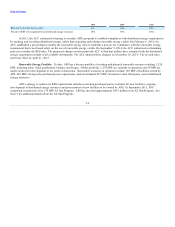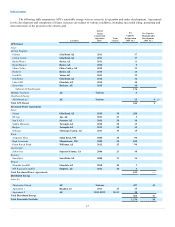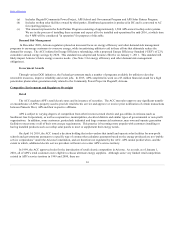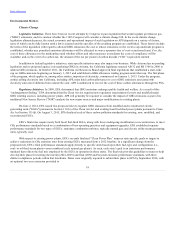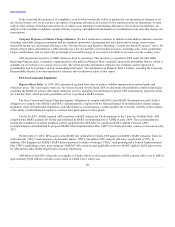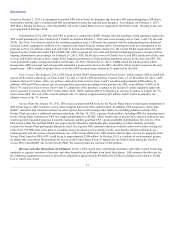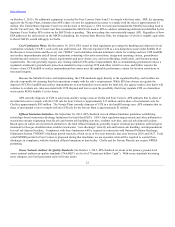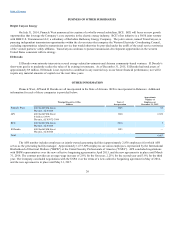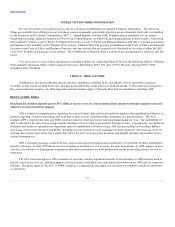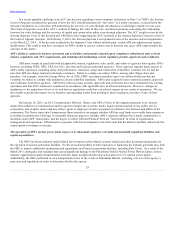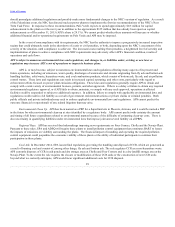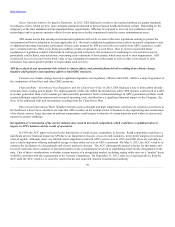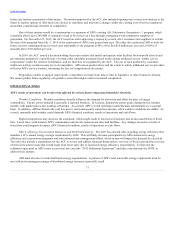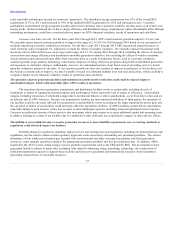APS 2015 Annual Report Download - page 25
Download and view the complete annual report
Please find page 25 of the 2015 APS annual report below. You can navigate through the pages in the report by either clicking on the pages listed below, or by using the keyword search tool below to find specific information within the annual report.
Table of Contents
on October 1, 2015). No additional equipment is needed for Four Corners Units 4 and 5 to comply with these rules. SRP, the operating
agent for the Navajo Plant, estimates that APS's share of costs for equipment necessary to comply with the rules is approximately $1
million. The United States Supreme Court’s recent decision in Michigan vs. EPA reversed and remanded the MATS proceeding back to
the DC Circuit Court. The Circuit Court then remanded the MATS rule back to EPA to address rulemaking deficiencies identified by the
Supreme Court. Further EPA action on the MATS rule is pending. This proceeding does not materially impact APS. Regardless of how
EPA addresses the deficiencies in the MATS rulemaking, the Arizona State Mercury Rule, the stringency of which is roughly equivalent
to that of MATS, would still apply to Cholla.
Coal Combustion Waste. On December 19, 2014, EPA issued its final regulations governing the handling and disposal of coal
combustion residuals (“CCR”), such as fly ash and bottom ash. The rule regulates CCR as a non-hazardous waste under Subtitle D of
the Resource Conservation and Recovery Act (“RCRA”) and establishes national minimum criteria for existing and new CCR landfills
and surface impoundments and all lateral expansions consisting of location restrictions, design and operating criteria, groundwater
monitoring and corrective action, closure requirements and post closure care, and recordkeeping, notification, and Internet posting
requirements. The rule generally requires any existing unlined CCR surface impoundment that is contaminating groundwater above a
regulated constituent’s groundwater protection standard to stop receiving CCR and either retrofit or close, and further requires the
closure of any CCR landfill or surface impoundment that cannot meet the applicable performance criteria for location restrictions or
structural integrity.
Because the Subtitle D rule is self-implementing, the CCR standards apply directly to the regulated facility, and facilities are
directly responsible for ensuring that their operations comply with the rule’s requirements. While EPA has chosen to regulate the
disposal of CCR in landfills and surface impoundments as non-hazardous waste under the final rule, the agency makes clear that it will
continue to evaluate any risks associated with CCR disposal and leaves open the possibility that it may regulate CCR as a hazardous
waste under RCRA Subtitle C in the future.
APS currently disposes of CCR in ash ponds and dry storage areas at Cholla and Four Corners. APS estimates that its share of
incremental costs to comply with the CCR rule for Four Corners is approximately $15 million, and its share of incremental costs for
Cholla is approximately $85 million. The Navajo Plant currently disposes of CCR in a dry landfill storage area. APS estimates that its
share of incremental costs to comply with the CCR rule for the Navajo Plant is approximately $1 million.
Effluent Limitation Guidelines. On September 30, 2015, EPA finalized revised effluent limitation guidelines establishing
technology-based wastewater discharge limitations for fossil-fired EGUs. EPA’s final regulation targets metals and other pollutants in
wastewater streams originating from fly ash and bottom ash handling activities, scrubber activities, and coal ash disposal leachate.
Based upon an earlier set of preferred alternatives, the final effluent limitations generally require chemical precipitation and biological
treatment for flue gas desulfurization scrubber wastewater, “zero discharge” from fly ash and bottom ash handling, and impoundment
for coal ash disposal leachate. Compliance with these limitations will be required in connection with National Pollution Discharge
Elimination System ("NPDES") discharge permit renewals, which occur in five-year intervals, that arise between 2018 and 2023. Until
a draft NPDES permit for Four Corners is proposed during that timeframe, we are uncertain what will be required to control these
discharges in compliance with the finalized effluent limitations at that facility. Cholla and the Navajo Plant do not require NPDES
permitting.
Ozone National Ambient Air Quality Standards. On October 1, 2015, EPA finalized revisions to the primary ground-level
ozone national ambient air quality standards (“NAAQS”) at a level of 70 parts per billion (“ppb”). With ozone standards becoming
more stringent, our fossil generation units will come under
22



